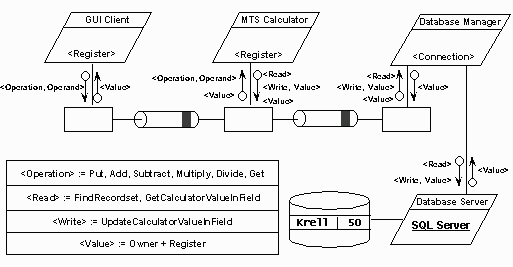Chapter 1: WFC, J/Direct, and All That Jazz…, introduces the benefits to using Java, characterizes the different versions of Java available for your development language, and performs a qualitative evaluation among the available versions.
|
Chapter 2: A Conceptual Overview of Windows Programming, provides an introduction into the components of Windows NT, describes the usage of queues, messaging, and device interfaces for obtaining hardware independence, and defines the design approach for event oriented applications.
|
Chapter 3: Just a Small Cup of Java, Please, analyzes a simple Java program, characterizes the programming features of Java commonly used when implementing in all versions of Java, and introduces classes and class inheritance hierarchies.
|
Chapter 4: So, Which Version Of Java Should I Use?,, implements the infamous Hello, Windows! program in WFC, J/Direct, Pure Java, and WFC/DHTML and performs a quantitative comparison study of the implementations.
|
Chapter 5: And, Now For A Little Fun, implements a simple animation program in WFC, J/Direct, and Pure Java, demonstrates support for graphic device hardware independence provided by each version of Java, and shows the usage of timers in each version of Java.
|
Chapter 6:Providing A Graphical User Interface, defines a basic set of controls supported by all the versions of Java, describes creation, initialization, servicing, and termination of each of the controls, and implements each of the controls in WFC, J/Direct, Pure Java, and WFC/DHTML.
|
Chapter 7:Implementing A Drawing Program Using WFC, implements a basic Computer Aided Drawing (CAD) program using WFC, demonstrates adding support for drawing with rubber banding, typing and echoing of characters, incorporating menus, using popup dialogs to set parameters, and shows you how to define your own events.
|
Chapter 8:Implementing A Drawing Program Using J/Direct, implements the same basic CAD program using J/Direct, adding the same features as the WFC version.
|
Chapter 9:Implementing A Drawing Program Using Pure Java, implements the same basic CAD program using Pure Java, adding the same features as the WFC version.
|
Chapter 10:Controlling Access With A LogOn Dialog, demonstrates using dialogs and class localized events to perform access control, implements a logon dialog class using WFC, J/Direct, Pure Java, and WFC/DHTML, and utilizes support for hiding passwords.
|
Chapter 11:Threading And Synchronization, defines software threads, synchronization concepts, and the reentrancy problems, introduces a multithreaded synchronization architecture for solving a simple reentrancy problem, and implements the multithreaded architecture in WFC, J/Direct, and Pure Java.
|
Chapter 12:Using COM and ActiveX With Java, demonstrates using existing COM and ActiveX controls from Java clients, illustrates implementing COM and ActiveX servers in Java, and shows usage of these Java servers from Java clients and Visual Basic clients.
|
Chapter 13:Supporting ActiveX Data Objects, introduces the ADO object architecture, implements a simple wrapper class for ADO, and demonstrates using the ADO wrapper class with MS Access.
|
Chapter 14:A Simple 3-Tiered Application In Java, defines a sample system that includes a graphical user interface, a stateless middle-tier business logic object, and a low-level data manager object, and implements the system with two interfaces - application interface and web browser interface.
|
Appendix A:Navigating the Accompanying CDROM, provides installation and organization information for using the accompanying CDROM.
|
Appendix B: A Simple Step By Step Tutorial On Using Visual J++, walks you through a complete project definition, coding, debugging, and testing cycle using the simple Java program from Chapter 3.
|
Appendix C: Quick Reference To WFC: provides you with a thumbnail reference guide to the Windows Foundation Classes, shows class names, field names and their data types, and method signatures, and gives some explanation as to the class capabilities.
|

